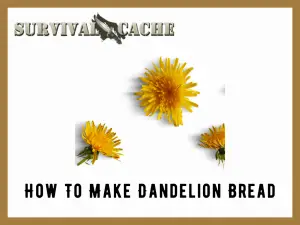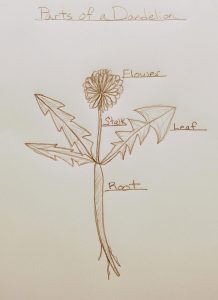Often when I walk out the front door, I am confronted with the sight of little yellow flowering plants peppered throughout my lawn.
I have heard more times than I care to remember that dandelions are “weeds,” and should be removed.

But take a minute and think about this, “what is a weed?” It is nothing more than an unwanted plant growing in a particular environment.
Take the area of a garden or farm field for example. The only thing the grower wants to see in that area are the food plants that have been planted. Everything else that grows in that area takes resources away from the food plants and we deem it a “weed.”
So, if I do not like roses but find them growing in my yard where I do not want them, I would consider them a weed and I think most people would consider that as absurd.
This is how I have come to view most plants, not as weeds but in terms of their potential uses. And dandelions being as nutritious as they are, should be on your radar, especially since they seem to grow everywhere.
SKIP AHEAD
Dandelion Nutrition Facts
Great lengths are taken every year to eradicate these little yellow flowering plants, which is a bit confusing because they contain a lot of nutrition.
They are packed with minerals, vitamins, and fiber.
The green part of the dandelion contains vitamins A, C, K, E, B, and folate. There is also a good amount of minerals found in this “weed” that includes magnesium, potassium, iron, and calcium, not to mention the carbohydrates found in the root.
Other benefits of the dandelion include:
- Contains antioxidants
- May aid in a host of health issues, some of which include maintaining blood sugar, inflammation, and digestive problems
Harvesting Dandelions for the Recipe
Dandelion leaves are tender and best eaten raw in the early spring when the weather is cool with a bit of humidity is in the air.

During mid-spring, the flowers can be gathered, and the roots can be harvested throughout the year.
One thing to keep in mind when harvesting wild edibles are the environments in which they grow. Certain contaminants like chemical sprays, industrial runoff, and other pollutants can cause otherwise edible plants to be unsafe to consume.
For the above reason, it is important to always be confident that the area in which wild edibles are harvested is safe. This requires knowledge of the history as well as the current use of the harvest area as well as the surrounding land.
It is also critical to remember the importance of properly identifying plants. Often, there are several different types of plants that closely resemble one another. It is best to always use a field guide for identifying wild edibles accurately, and safely or to be taught by someone who is knowledgeable on the topic.
Tools
When it comes time to gather up your dandelions, there are a few tools that will make the harvesting process easier. Consider having:
- Cutting sheers. These will help to cut away various parts of the plant.
- Trowel. A small digging tool, such as a trowel, aids in digging up the entire dandelion and exposing the roots.
- Collection container. Unless you are only gathering a handful of dandelions, you are going to want a container for carrying the plants from the field to the home. A small basket, pail, or bucket works well.
Preparing Dandelions
After the dandelions have been collected, the next step is to wash them.
They can be cleaned in the same manner as you wash vegetables you get from the store or your garden. Simply place the dandelion under a stream of warm water and gently scrub to remove any dirt and other debris.
However, another option would be to wash the dandelions in a water and vinegar mixture that is supposed to help get rid of any bacteria.
After washing, put the wet dandelions on a towel and pat dry. Next, use cutting sheers to remove the desired parts, flower, stems, leaves, and roots.
Separate the different parts of the plants to be used in various recipes. In the following bread recipe, only the flowers will be used.
But since you went to all the hard work of harvesting and cleaning the dandelions, do not throw the other parts away! There is a small section after the bread recipe for how to eat other portions of this plant.
Dandelion Bread Recipe
This dandelion recipe obtained from AskAPrepper.com.
What you will need:
- Enough dandelion flowers to fill approximately one cup
- Two cups of flour
- Two tsp of baking powder
- One egg
- A little bit of salt
- 1 ¼ cup of milk
- 3 tbsp oil (your choice)
- Add ¼ cup of your choice of honey, sugar, or another sweetener
- A small bread pan that can be greased or used with parchment paper
The first step is to preheat your oven to 400 degrees.
Next, cut the yellow flower away from the stem and add the flowers into the flour along with the salt. You can crumble the flowers in but they will break apart during the mixing process.
After the above has been combined, mix in the egg, oil, sweetener, and milk. Stir all the ingredients until everything is well blended.
Pour the mixture into a bread pan that is greased or lined with cooking paper.
Place the pan into the oven for at least fifteen minutes. Lower the temperature to 350 degrees and continue to bake for an additional twenty-five minutes.
After the last twenty-five minutes of cooking, pull the pan from the oven and allow the bread to cool. Cut into slices and enjoy!
Like most homemade bread this loaf will taste the best if consumed as soon as possible. Warm bread right out of the oven topped with your favorite spread is the best way to eat. However, when the bread is wrapped up, it will last several days so it can be eaten later.
Other Ways to Eat Dandelion
The leaves of the dandelion can be picked and eaten raw, or they can be added to a salad full of other delicious greens. The greens can also be used on sandwiches or as a garnish.
After digging them up, the roots can be boiled in a pot of water or roasted in a pan.
According to Lisa M. Rose author of Midwest Foraging 115 wild and flavorful edibles from burdock to wild peach1, dried and roasted dandelion roots can be added into a blended tea mixture, which brings out a sweet, nutty flavor.
Dandelion roots can also be roasted, ground into a powder, and used to make what some describe as a great substitute for coffee.
Wrap Up
Wild edibles are all around us, they are free, and can be highly nutritious.
Dandelions as well as many other plants are highly underrated in their usefulness not only in the environment but to us as a material and food source.
By becoming knowledgeable in this free source of food we may stop looking at a lot of plants as “weeds” but as healthy alternatives that we can add to the dinner table for creating and maintaining a healthy diet.
Thanks for reading and keep baking!
Have you ever made dandelion bread or eaten dandelions? Sound off in the comment section below and let us know!

